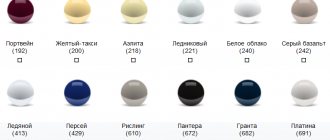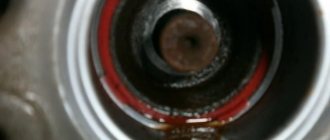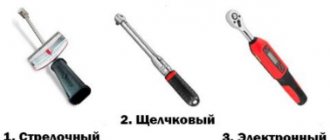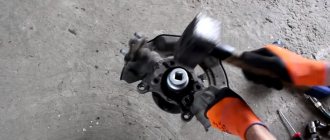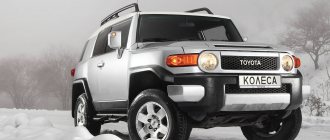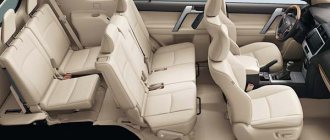Payment for goods and downloading of the book in electronic form (PDF format) is made on the website.
To do this, you need to find the book you are interested in and click on the “Buy” button. The price of the book is indicated on the button.
For convenience, the price on the website for residents of Russia, Belarus and Kazakhstan is presented in rubles.
For residents of Ukraine in hryvnias, and for all other countries - dollars.
After clicking on the “BUY” button, a payment window will open where you can select a payment system with which you can pay for the selected book using any bank card (Visa, MasterCard, MIR, etc.)
When you click on the “Pay by bank card” button, the Portmone payment system will open, which is the easiest way to make a payment.
In addition, the website offers four payment systems for payment:
- Yandex (payment from any bank cards, Yandex Money account, QIWI Wallet, terminals, etc.);
- Portmone (payment from any bank cards, Portmone account);
- PayPal (payment from any bank cards, PayPal account);
- WebMoney (payment from any bank cards, payment from WebMoney wallets).
Payment via Yandex Cashier
After selecting payment via Yandex, the Yandex Cashier payment system will launch, where you need to select a convenient payment method (bank card, QIWI, Yandex Money account, etc.)
After specifying payment details and confirming payment, payment for the goods will occur.
If you have a bank card in a currency other than the ruble, then the money will be debited from the card at the rate of the Central Bank of Russia at the time of the purchase.
This payment method is optimal for residents of Russia, Kazakhstan and Belarus.
Official website of the Yandex Kassa payment system https://kassa.yandex.ru
Payment via Portmone
After selecting payment through Portmone, the payment system will launch, where you need to select the payment method: bank card or Portmone account.
The price in the Portmone payment system is converted into dollars at the exchange rate of the Central Bank of the country where you are located.
If you have a bank card in a currency other than the dollar, then the money will be debited from the card at the rate of the Central Bank of your country at the time of the purchase.
After specifying payment details and confirming payment, payment for the goods will occur.
Official website of the Portmone payment system https://www.portmone.com
Removing and installing a steering wheel with an airbag Toyota RAV4
- Repair manuals
- Repair manual for Toyota Rav4 1994-2000.
- Removing and installing a steering wheel with an airbag
| WARNING Vehicles are equipped with safety systems (SRS), including airbags and seat belt tensioners. Before working around the shock sensors, instrument panel and steering column, first disconnect the negative and then the positive terminals from the battery and wait 2 minutes. This will prevent unauthorized deployment of airbags and seat belt pretensioners, which could cause personal injury. |
Remove the steering wheel as follows:
Turn off the ignition, disconnect the ground wire from the battery and wait 2 minutes before carrying out further work.
Set the wheels to drive straight.
On 1996 and 1997 models, release the clips on the sides and remove the center pad from the steering wheel.
| Rice. 13.1. Loosening the screw securing the airbag to the steering wheel |
On 1998-later models, loosen the screws that secure the airbag to the steering wheel, located on either side of the rear of the steering wheel ( ).
Loosen each screw until the tab on the screw comes out of the housing.
| Rice. 13.2. Disconnecting the airbag electrical connector on models since 1998 |
Tilt the airbag back ( ), disconnect the electrical connector and remove the airbag.
Place the pillow in a safe place with the bag facing up.
| Rice. 13.3. Location of electrical connectors for horn and cruise control switch |
Disconnect the electrical connector for the horn and, if equipped, the cruise control switch ( ).
Remove the steering wheel mounting nut.
Using chalk, a marker or paint, apply alignment marks to the steering wheel and the end of the steering shaft. The marks are necessary to reinstall the steering wheel to its original position.
| Rice. 13.4. Using a puller to remove the steering wheel |
Using a puller, remove the steering wheel from the shaft ( ).
| WARNING Do not knock on the shaft or steering wheel when removing the steering wheel. Also, do not turn the steering shaft with the steering wheel removed, otherwise the airbag coil wire will be misaligned and may be broken when the steering wheel is installed. |
| Rice. 13.5. Location of the clamps (1) for fastening the spiral wire of the airbag on models from 2001 |
If it is necessary to remove the airbag coil wire, disconnect the electrical connector, then remove the 4 screws (pre-2001 models) or 3 clips (2001-later models) and separate it from the combination switch ( ).
Install the steering wheel as follows:
Make sure the front wheels are set to drive straight, then center the airbag coil wire.
| Rice. 13.6. Aligning the marks (1) when centering the airbag spiral wire |
Turn the spiral wire sleeve counterclockwise until it stops, but do not apply too much force, as the wire may be torn. Turn the spiral wire bushing clockwise 2.5 turns and align the marks shown in .
Install the steering wheel, aligning the marks made before removal. Secure the steering wheel with the nut, tightening it to the torque specified in the technical data.
Connect the electrical connector for the horn and, if equipped, the cruise control switch (see ).
Connect the airbag electrical connector. Check that the airbag electrical connector is correctly positioned and the wires are loose, then install the airbag on the steering wheel and secure it with the screws.
Connect the ground wire to the battery.
↓ Comments ↓
1. Introduction
1.0 Introduction
2. Vehicle operation
2.0 Vehicle operation 2.1. Controls, instruments and equipment 2.2 Engine compartment 2.3. Keys and ignition switch 2.4. Starting the engine 2.5 Manual gearbox 2.6. Automatic transmission (AKP) 2.7 Recommendations for driving a car on rough terrain 2.8 Parking brake 2.9 Switch for direction indicators and headlights 2.22. Doors 2.25. Installing mirrors 2.27. Front seats 2.28. Rear seats 2.29. Seat belts 2.31. Lifting a car with a jack
3. Maintenance
3.0 Maintenance 3.1 General information on operating materials and adjustment data 3.2. Scope and frequency of maintenance 3.3. Checking the levels of operating fluids 3.4 Inspecting the tires and checking the air pressure 3.5 Replacing the engine oil and oil filter 3.6 Checking and replacing the rubber bands of the wiper blades 3.7 Checking and adjusting the free play of the clutch pedal 3.8. Checking, maintaining and charging the battery 3.9. Checking, adjusting the tension and replacing the poly-V-belt drive of mounted units 3.13. Checking the condition of the brakes (every 24,000 km or 12 months) 3.18. Checking the condition of the suspension and steering 3.26. Replacing the coolant and flushing the cooling system 3.34. Checking and adjusting clearances in the valve drive
4. Engines
4.0 Engines 4.1. Repairing the 3S-FE engine without removing it from the car 4.2. Repairing the 1AZ-FE engine without removing it from the car 4.3. Diagnostics and preparation of the engine for major repairs
5. Cooling and air conditioning systems
5.0 Cooling and air conditioning systems 5.1. General information 5.2 Technical data 5.3. Maintenance and repair of the cooling system 5.4. Checking and servicing the air conditioning system
6. Fuel system and exhaust system
6.0 Fuel system and exhaust system 6.1 General information 6.2 Technical characteristics of the fuel injection system 6.3 Relieving pressure in the fuel system 6.4. General check of the fuel system 6.5 Fuel pump 6.6 Fuel pressure regulator 6.7 Fuel level sensor 6.8 Fuel tank 6.9 Air filter housing 6.11. Electronic fuel injection system 6.14. Exhaust system
7. Ignition system
7.0 Ignition system 7.1. General information 7.2 Precautions during operation and repair of the ignition system 7.3 Technical characteristics of the ignition system 7.4. Checking the ignition system and its elements
8. Systems for monitoring and reducing exhaust gas toxicity
8.0 Systems for monitoring and reducing exhaust gas toxicity 8.1 General information 8.2 Technical characteristics 8.3 On-board diagnostic system (OBD) 8.4. Information sensors and actuators 8.5 OBD-II system fault codes 8.6 Engine control unit (PCM) 8.7. Sensors and valves of the fuel injection system (EFI) 8.8 Positive crankcase ventilation (PCV) system 8.9 Exhaust gas recirculation (EGR) system on models since 2001
9. Clutch
9.0 Clutch 9.1 General information 9.2 Technical data 9.3 Clutch master cylinder 9.4 Clutch slave cylinder 9.5 Clutch hydraulic bleed 9.6 Clutch driven disc 9.7 Clutch release bearing 9.8 Clutch switch
10. Gearbox
10.0 Gearbox 10.1 General information 10.2 Technical data 10.3 Gearbox repair 10.4. Repair and adjustment work performed on vehicles with a manual transmission 10.5. Repair and adjustment work performed on vehicles with automatic transmission
11. Cardan shaft and drive shafts
11.0 Cardan shaft and drive shafts 11.1 General information 11.3. Front wheel drive shafts 11.4. Rear wheel drive shafts on all-wheel drive vehicles 11.5. Replacing the protective covers of the wheel drive shaft joints 11.6. Cardan shaft 11.7. Support bearing of the cardan shaft 11.8. Sealing cuffs of the rear final drive 11.9. Differential on all-wheel drive vehicles
12. Brake system
12.0 Brake system 12.1 General information 12.2 Technical data 12.3. Anti-lock brake system (ABS) 12.4 Replacing the front brake pads 12.5. Replacing the front brake caliper 12.6. Checking and replacing brake discs 12.7 Replacing rear brake pads 12.8. Replacing the working brake cylinder 12.9. Replacing the main brake cylinder 12.11. Replacing brake pipes and hoses 12.13. Checking and replacing the vacuum brake booster 12.15. Replacing parking brake cables 12.16. Adjusting the position of the brake pedal 12.17. Checking and replacing the brake light switch
13. Suspension
13.0 Suspension 13.1 General information 13.2 Technical data 13.3. Front suspension strut 13.4. Dismantling and assembling the shock-absorbing strut 13.5. Front anti-roll bar 13.6. Lower arm of the front suspension 13.7. Steering knuckle and front wheel hub 13.8. Rear anti-roll bar 13.9. Rear suspension shock absorber 13.10. Rear suspension arms 13.12. Rear wheel hub and bearing
14. Steering and chassis
14.0 Steering and chassis 14.1 General information 14.2 Technical characteristics 14.3 Removing and installing a steering wheel with an airbag 14.4 Removing and installing a steering column 14.5 Removing and installing tie rod ends 14.6 Replacing steering gear boots 14.7 Removing and installing a steering gear 14.8 Removing and installing a pump power steering 14.9 Bleeding the hydraulic system of the power steering 14.11. Wheels and tires
15. Body
15.0 Body 15.1 General information 15.2. Body care 15.3. Caring for upholstery and rugs 15.4. Repair of minor damage to the body 15.5 Repair of significant damage to the body 15.6 Maintenance of hinges and locks 15.7 Recommendations for replacing the windshield and fixed windows 15.8 Removing and installing the hood 15.9 Lock and cable for opening the hood lock 15.10. Removing and installing bumpers 15.14. Removing and installing door trim 15.15. Doors 15.16. Removing and installing door glass 15.17. Removing and installing window regulators 15.20. Tailgate 15.22. Removing and installing instrument panel trim elements 15.25. Removing and installing seats
16. Electrical equipment
16.0 Electrical equipment 16.1. General information 16.2 Technical characteristics 16.3. Electrical circuits 16.4. Checking the battery 16.5 Replacing battery cables 16.6. Fuses and relays 16.7 Checking and replacing the turn signal and hazard warning light relays 16.8 Checking the charging system 16.9. Generator 16.10. Engine starting system 16.13. Removing and installing instrument panel switches 16.15. Checking and replacing the windshield wiper motor 16.16. Radio and speakers 16.17. Replacing the antenna 16.27. Checking the central locking system 16.29. Airbags
17. Electrical diagrams
17.0 Electrical diagrams 17.1 Diagrams 1-10 17.2 Diagrams 11-20 17.3 Diagrams 21-32
Payment via PayPal
After selecting payment via PayPal, the PayPal payment system will launch, where you need to select the payment method: bank card or PayPal account.
If you already have a PayPal account, then you need to log into it and make a payment.
If you do not have a PayPal account and you want to pay using a bank card via PayPal, you need to click on the “Create an Account” button - shown with an arrow in the picture.
PayPal will then prompt you to select your country and provide your credit card information.
After specifying the information required to make the payment, you must click on the “Pay Now” button.
Official website of the PayPal payment system https://www.paypal.com
Payment via WebMoney
After selecting payment via WebMoney, the payment system will launch, where you need to select the payment method: bank card or WebMoney wallet.
If you already have a WebMoney wallet, then you need to log into it and make a payment.
If you do not have a WebMoney wallet and you want to pay in another way, you need to select any of the methods that WebMoney offers and make the payment
After specifying payment details and confirming payment, payment for the goods will occur.
Official website of the WebMoney payment system https://www.webmoney.ru/
Downloading a book
After successfully completing the payment (by any method) and returning to the KrutilVertel store from the payment system website, you will be taken to the successful payment page:
On this page you need to indicate your e-mail, where access to download the book will be sent.
If you are already registered on our website, then simply follow the link to your personal account.
The book you purchased will be in your personal account, from where you can always download it.
Please note that after making the payment, you need to return back from the payment system website to the KrutilVertel website.
If for some reason you did not return back to the site and closed the payment system tab with a message about the successful completion of the payment, please let us know - we will send you a letter indicating access to download the book.
Steering wheel - removal and installation
Attention! Before working near impact sensors, the steering column or the instrument panel, to prevent unauthorized deployment of the airbag, which could result in personal injury, disconnect the cable from the negative terminal of the battery (see Chapter 12).
Attention! Do not use any external power sources to save settings and memory of electronic devices when working with SRS system components.
Removal
1. Turn the ignition key to the OFF position, then disconnect the negative battery cable. Wait at least two minutes before starting work.
2. Turn the steering wheel so that the front wheels are in the straight-ahead position. On 1996 and 1997 models, carefully pry and remove the trim trim on both sides of the steering wheel. On all models, loosen the Torx screws that secure the airbag module to the steering wheel (see Fig. 14.2). Loosen each screw until the groove around the circumference of the screw engages the edge of the chassis, but do not attempt to remove the screws completely from the chassis.
Rice. 14.2. Loosen the Torx screws enough to remove the airbag module.
3. Remove the airbag module from the steering wheel (see Fig. 14.3, a), open the locking device of the wiring connector and disconnect the module connector (see Fig. 14.3, b). Store the module in a safe place and out of reach of unauthorized persons.
Rice. 14.3, a. Lift up and separate the airbag module from the steering wheel.
Rice. 14.3, b. Open the connector lock and disconnect the wiring connector - 1998 model shown. Pull the locking device in the direction shown by the arrow. In earlier models, the locking device is opened by pressing the latch
Attention! When working with the module, hold it with the pad facing away from you. Store the removed module in a safe place with the cover facing up; don't put anything on top of it.
4. Disconnect the horn wiring connector and, if equipped, the cruise control switch connector (see Fig. 14.4).
Rice. 14.4. Disconnect the horn and cruise control switch wiring connectors.
5. Unscrew the steering wheel mounting nut, then apply relative position marks to the steering wheel hub and steering shaft, if they do not already exist, in order to correctly install the steering wheel in place during assembly (see Fig. 14.5).
Rice. 14.5. Before removing the steering wheel, apply relative position marks to the steering wheel hub and steering shaft.
6. Remove the steering wheel from the shaft, using a special puller if necessary (see Fig. 14.6).
Rice. 14.6. If the steering wheel does not come off the shaft, use a special puller to remove it.
Attention! When pulling the steering wheel off the shaft, do not hit either the shaft or the puller with a hammer. Do not rotate the steering shaft with the steering wheel removed - this will disrupt the alignment of the airbag spiral contact and may cause it to break during vehicle operation.
7. If the airbag spiral contact needs to be removed, disconnect the wiring connector, unscrew the four fastening bolts (models up to 2000) or release the three clamps (models from 2001) and remove the contact from the steering column switch (see Fig. 14.7).
Rice. 14.7. In models produced since 2001, the airbag spiral contact is secured with three clips
Installation
8. Ensuring that the front wheels are in the straight ahead position, center the helical contact as follows: rotate the helical contact rotor counterclockwise until it stops (do not apply excessive force), then turn it 2.5 turns clockwise and align the marks (see Fig. 14.8).
Rice. 14.8. Once you have centered the helical contact, make sure the marks are aligned
9. Install the steering wheel, aligning the marks on the wheel hub and the steering shaft. Screw in the steering wheel fastening nut and tighten it to the torque prescribed in the Specifications.
10. Connect the cruise control switch and horn wiring connectors.
11. Connect the airbag module wiring connector and close the connector lock.
12. After making sure that the airbag module connector is in the correct position and its wiring is not pinched anywhere, install the airbag module and tighten its mounting screws to the specified torque.
13. Connect the cable to the negative terminal of the battery.
Problems when paying with bank cards
Sometimes difficulties may arise when paying with Visa/MasterCard bank cards. The most common of them:
- There is a restriction on the card for paying for online purchases
- A plastic card is not intended for making payments online.
- The plastic card is not activated for making payments online.
- There are not enough funds on the plastic card.
In order to solve these problems, you need to call or write to the technical support of the bank where you are served. Bank specialists will help you resolve them and make payments.
That's basically it. The entire process of paying for a book in PDF format on car repair on our website takes 1-2 minutes.
If you still have any questions, you can ask them using the feedback form, or write us an email at [email protected]
Diagnostics
Everyone knows that car maintenance is a fairly large expense item in the budget of every owner of a foreign passenger car. Repairing a RAV4 will also cost its owner a tidy sum if you don’t follow one simple rule that all experienced car enthusiasts know. This rule is very simple - regular computer diagnostics are necessary, which will help eliminate problems at an early stage of their development. Eliminating only emerging breakdowns is a fairly cheap procedure that does not require significant financial impact.
If you want to service, diagnose or repair a Toyota RAV4, contact us, we will help!
Technical specialists carry out repairs and maintenance of the Toyota RAV4, an all-wheel drive compact car that has become widespread in the global automotive market over almost twenty years of production. Production of this all-wheel drive passenger car began in 1994 at the corporation's Japanese factories.
From the very beginning of production, this car was positioned as an all-wheel drive car for young people who love active recreation. The managers' calculation was correct - the RAV 4 quickly became a cult car among local wealthy young people. Even the network of technical centers that service the machine had to be significantly expanded, so great was its popularity.
The first generation of cars of this family had some shortcomings, which, however, were easily eliminated in a service center specialized in Toyota RAV4. Maintenance and timely diagnostics made it possible to keep this car in good condition for years. In the next generations, design errors are taken into account and owners of cars belonging to the third (current) generation do not have to contact a technical center so often to have their Toyota RAV4 serviced.

